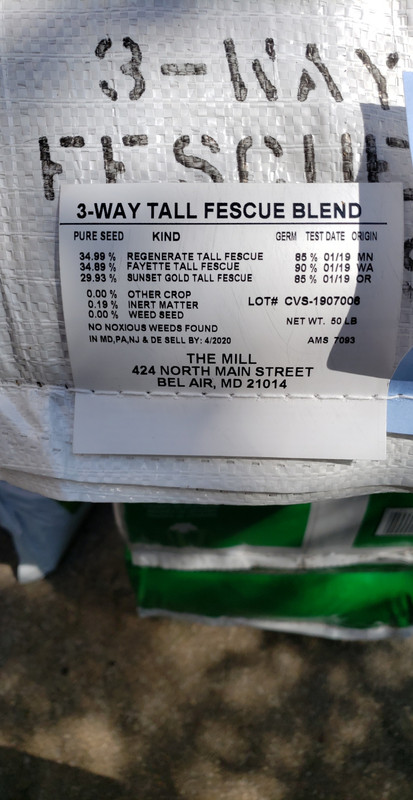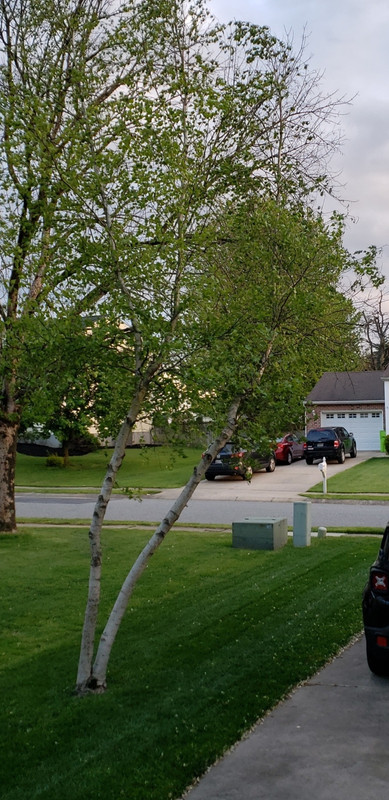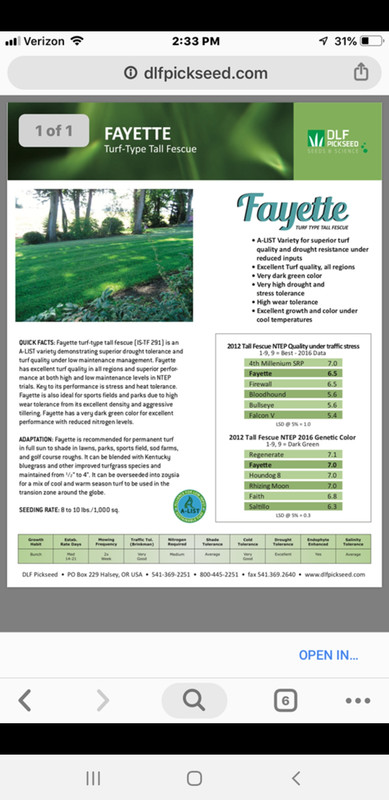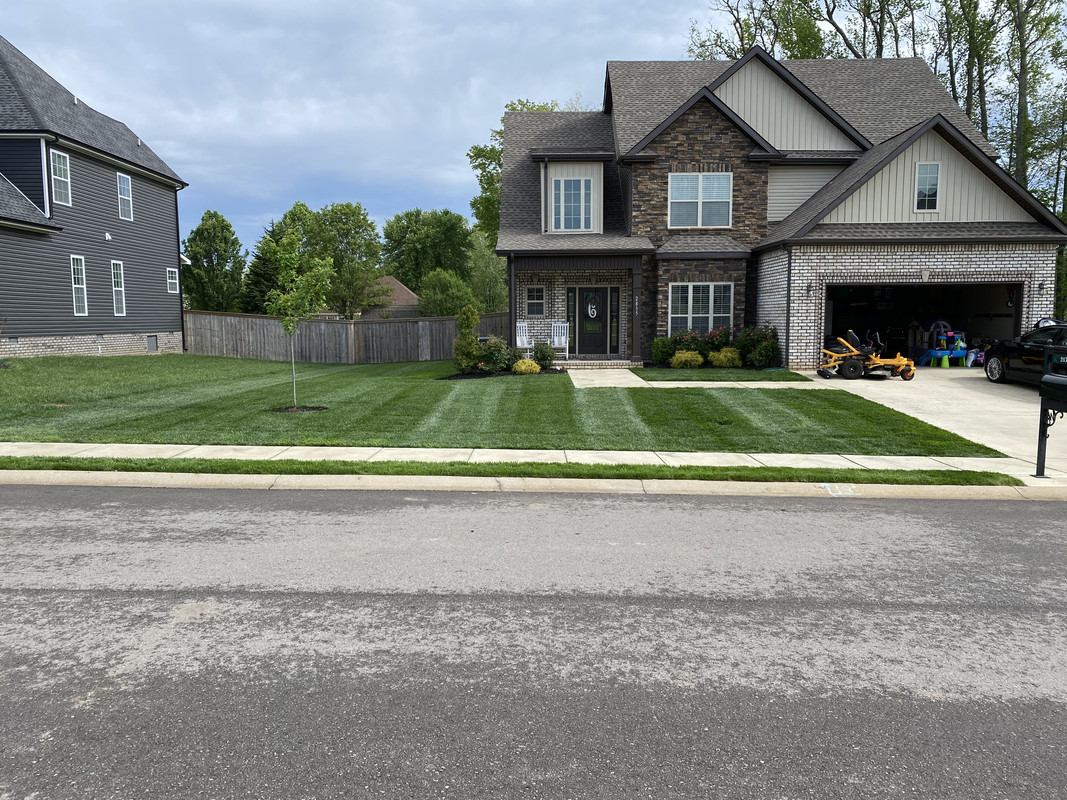Anyone have any current NTEP studies that show the darkest TTTF that can be purchased?

Darkest TTTF
1 reading
Scagfreedom48z+
21 - 40 of 148 Posts
Joined
·
2,111 Posts
I think you got me sold on it. Did you do a full reno or overseed of an existing lawn? Rate?CrackedCornCrack said:@Scagfreedom48z+ , try SnapBack RR this fall, plus any methods to raise your ph.
@SwardEnthusiast will probably agree, SnapBack is ridiculously dark in his lawn and mine, regardless of time of day, and especially compared to other TTTF that we have/had.
I haven't seen it through a full summer, so I'm not sure about heat.
This picture was taken in Jan or feb with the lawn between 1.5- 2 inches

@Scagfreedom48z+
I agree with @CrackedCornCrack about raising pH, to help darken the lawn. I think the boatload of Fe you have in your soil (from Milo, I presume?), may be locked up with your low pH. I'm not 100% positive, but I recall reading somewhere about how pH relates to iron and other micronutrients. Unable to pick up lime and SOP from my local supplier with this Covid mess (avoiding crowds/contact), I ordered and applied one round of Cal-Flo from Do My Own and color improved noticeably. Also, after applying Growth Products 0-0-25 which has a pH of 12, it darkened even more (I have both low pH and a K deficiency, with high Fe results from my soil test).
I agree with @CrackedCornCrack about raising pH, to help darken the lawn. I think the boatload of Fe you have in your soil (from Milo, I presume?), may be locked up with your low pH. I'm not 100% positive, but I recall reading somewhere about how pH relates to iron and other micronutrients. Unable to pick up lime and SOP from my local supplier with this Covid mess (avoiding crowds/contact), I ordered and applied one round of Cal-Flo from Do My Own and color improved noticeably. Also, after applying Growth Products 0-0-25 which has a pH of 12, it darkened even more (I have both low pH and a K deficiency, with high Fe results from my soil test).
Joined
·
53 Posts
I agree with @CrackedCornCrack. SnapBack is super dark!
Joined
·
2,111 Posts
Just ordered 200 lbs of it!CrackedCornCrack said:@Scagfreedom48z+ , try SnapBack RR this fall, plus any methods to raise your ph.
@SwardEnthusiast will probably agree, SnapBack is ridiculously dark in his lawn and mine, regardless of time of day, and especially compared to other TTTF that we have/had.
I haven't seen it through a full summer, so I'm not sure about heat.
This picture was taken in Jan or feb with the lawn between 1.5- 2 inches
And this is today at 4.0
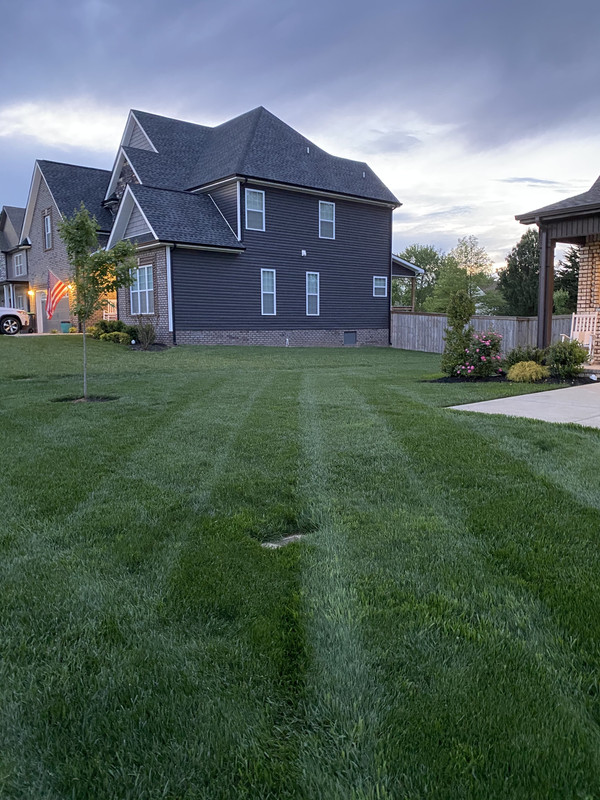
Joined
·
2,443 Posts
Fe availability is very good at low pH. It becomes locked up at pH above 7, though generally you need to get to high 7s to see an effect. A pH of 5.4 is likely to impact color from binding up of other nutrients, particularly Phosphorus. Raising pH will "release" Phos from the soil. Even then, you still need more Phos; the low pH is just adding to the problem.
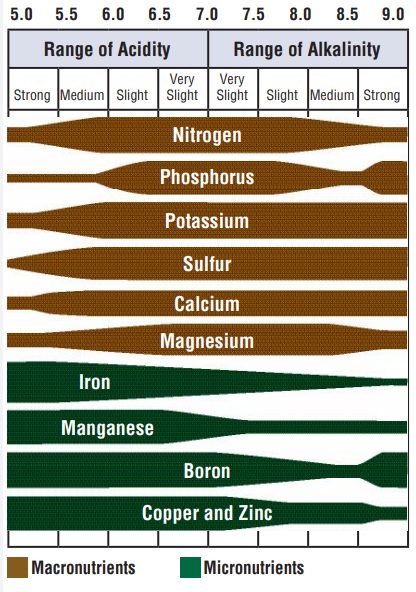

Joined
·
153 Posts
@bernstem ,
Can you explain the science behind acidic soil and leaf color (if that's a thing?)
I've anecdotally noticed that when people have lawns with a ph lower than 6 they generally struggle to get dark green grass.
Does ph have anything to do with that or is it potentially other deficiencies that and my observations on ph and color are just correlations and not causation.
Can you explain the science behind acidic soil and leaf color (if that's a thing?)
I've anecdotally noticed that when people have lawns with a ph lower than 6 they generally struggle to get dark green grass.
Does ph have anything to do with that or is it potentially other deficiencies that and my observations on ph and color are just correlations and not causation.
Joined
·
2,443 Posts
That is complicated, and I don't know that I really understand it at a granular level. All Biological systems are complicated and something like pH affects a lot of different things. I'll give a few examples, but it is much more complex than this. pH will change how soil binds nutrients, but not all soils are the same. Different clay soils will respond to pH changes differently. pH probably also directly affects the grass and its ability to pull in nutrients, but the act of pulling in Nitrogen also raises the pH immediately around the roots (Crazy!). Even crazier, some (many?/all?) plants will actually change their gene expression depending on the pH of the medium they are grown in. There are many more effects within the plant that are driven by nutrient levels inside the grass, which is influenced by all the above.
That is all interesting, but also not directly relevent to us. What we care about is how well the plants grow. There are a huge number of studies looking at soil macronutrient levels and pH and correlating them to plant health and growth. That data is what the soil testing recommendations draw on. Why grass does better with a pH of 6.5 and Phos of 4-14 PPM doesn't really matter. We know if we get the soil nutrients to a particular level (the specific level veries depending on test method - why that is the case is a whole different discussion) the grass will do better.
That is all interesting, but also not directly relevent to us. What we care about is how well the plants grow. There are a huge number of studies looking at soil macronutrient levels and pH and correlating them to plant health and growth. That data is what the soil testing recommendations draw on. Why grass does better with a pH of 6.5 and Phos of 4-14 PPM doesn't really matter. We know if we get the soil nutrients to a particular level (the specific level veries depending on test method - why that is the case is a whole different discussion) the grass will do better.
Joined
·
2,111 Posts
Great write up. So would my P&K levels be the issue here? Seems like my ph would fall into the sweet spot for iron levels.bernstem said:That is complicated, and I don't know that I really understand it at a granular level. All Biological systems are complicated and something like pH affects a lot of different things. I'll give a few examples, but it is much more complex than this. pH will change how soil binds nutrients, but not all soils are the same. Different clay soils will respond to pH changes differently. pH probably also directly affects the grass and its ability to pull in nutrients, but the act of pulling in Nitrogen also raises the pH immediately around the roots (Crazy!). Even crazier, some (many?/all?) plants will actually change their gene expression depending on the pH of the medium they are grown in. There are many more effects within the plant that are driven by nutrient levels inside the grass, which is influenced by all the above.
That is all interesting, but also not directly relevent to us. What we care about is how well the plants grow. There are a huge number of studies looking at soil macronutrient levels and pH and correlating them to plant health and growth. That data is what the soil testing recommendations draw on. Why grass does better with a pH of 6.5 and Phos of 4-14 PPM doesn't really matter. We know if we get the soil nutrients to a particular level (the specific level veries depending on test method - why that is the case is a whole different discussion) the grass will do better.
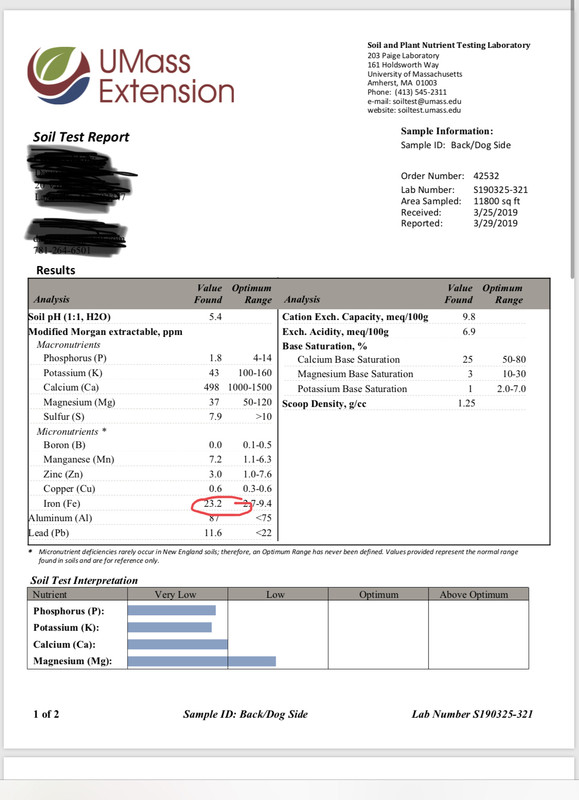
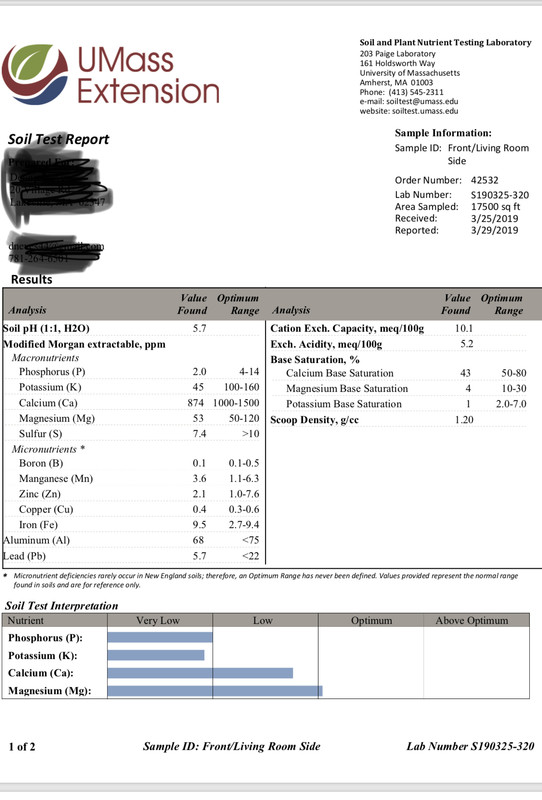
Joined
·
2,443 Posts
Phos and Potassium are likely contributing. Nitrogen also is important for color, but not very helpful to test for as it varies depending on what was applied since it doesn't stay in the soil. Generally speaking, you want to fix N/P/K deficiencies first before you start thinking about other things, though Iron is important enough for color we usually address it with N/P/K.Scagfreedom48z+ said:Great write up. So would my P&K levels be the issue here? Seems like my ph would fall into the sweet spot for iron levels.
Joined
·
2,111 Posts
Great information man! I know that this is a loaded questions but I'm hitting the lawn with #2 of SOP and TSP each. During the majority of my spoon feeding apps last year, especially during the fall blitz, I used Lesco 18-24-12. How long does it take to correct P&K?bernstem said:Phos and Potassium are likely contributing. Nitrogen also is important for color, but not very helpful to test for as it varies depending on what was applied since it doesn't stay in the soil. Generally speaking, you want to fix N/P/K deficiencies first before you start thinking about other things, though Iron is important enough for color we usually address it with N/P/K.Scagfreedom48z+ said:Great write up. So would my P&K levels be the issue here? Seems like my ph would fall into the sweet spot for iron levels.
Joined
·
2,443 Posts
P and K will correct immediately at the surface, but it will take time for it to work deeper into the soil profile. Your test should have recommended amounts to correct the deficiency. Generally 6-12 months is enough time for the P and K to work down. If you are testing the entire soil profile, the additions will show up immediately. If you are discarding the top of the profile, it may take a month or more to show up depending how much you are discarding. pH adjustments can take up to 3 years to work into the soil. Soil type and lime type affects how fast all that happens. There really isn't any reason to test more than yearly. Many midwest farmers test every 3 years.
Joined
·
2,111 Posts
Thanks for responding. Solid information here.bernstem said:P and K will correct immediately at the surface, but it will take time for it to work deeper into the soil profile. Your test should have recommended amounts to correct the deficiency. Generally 6-12 months is enough time for the P and K to work down. If you are testing the entire soil profile, the additions will show up immediately. If you are discarding the top of the profile, it may take a month or more to show up depending how much you are discarding. pH adjustments can take up to 3 years to work into the soil. Soil type and lime type affects how fast all that happens. There really isn't any reason to test more than yearly. Many midwest farmers test every 3 years.
Joined
·
2,111 Posts
Joined
·
873 Posts
Just gotta say that snapback looks awesome... if I ever decide to not let my lawn go dormant in the summer Ill switch from kbg to this... hopefully by then they cross breed with a rhizomatic type .
It seems snapback is no longer available 
https://unitedseeds.com/product-category/home-lawns/
https://unitedseeds.com/product-category/home-lawns/
Joined
·
7 Posts
It's 70% No Net and 30% Summer and both seem to be available so you can roll your own. Might add slightly to the cost and you might end up with some extra seed but if you want it badly enoughsowmyans said:It seems snapback is no longer available
https://unitedseeds.com/product-category/home-lawns/
Thanks, that is great 
Came to post this same thing... Anyone know the specific cultivars that were in the SnapBack RR? Or was that the actual cultivar name? Wonder why it was discontinued...sowmyans said:It seems snapback is no longer available
https://unitedseeds.com/product-category/home-lawns/
Joined
·
7 Posts
https://unitedseeds.com/wp-content/uploads/2019/01/SNAP-BACK.pdfgmorf33 said:Came to post this same thing... Anyone know the specific cultivars that were in the SnapBack RR? Or was that the actual cultivar name? Wonder why it was discontinued...sowmyans said:It seems snapback is no longer available
https://unitedseeds.com/product-category/home-lawns/
Pdf says 70-30 No Net to Summer, but it is kind of curious that both are listed in stock but the blend is unavailable.
Edit:
On the No Net page it says:
"Under the tradename No Net, Jacklin offers two varieties United Seeds sells interchangeably. Flame and JT783 are sold under the No Net trade name"
Perhaps the No Net variety in stock and the No Net variety used in the blend are not the same?
21 - 40 of 148 Posts
-
?
-
?
-
?
-
?
-
?
-
?
-
?
-
?
-
?
-
?
-
?
-
?
-
?
-
?
-
?
-
?
-
?
-
?
-
?
-
?
- posts
- 665K
- members
- 43K
- Since
- 2017
A forum community dedicated to lawn care, landscaping do it yourselfers, and enthusiasts. Come join the discussion to learn about industry equipment, tools, lawn care, lawn maintenance, classifieds, troubleshooting, and more!

